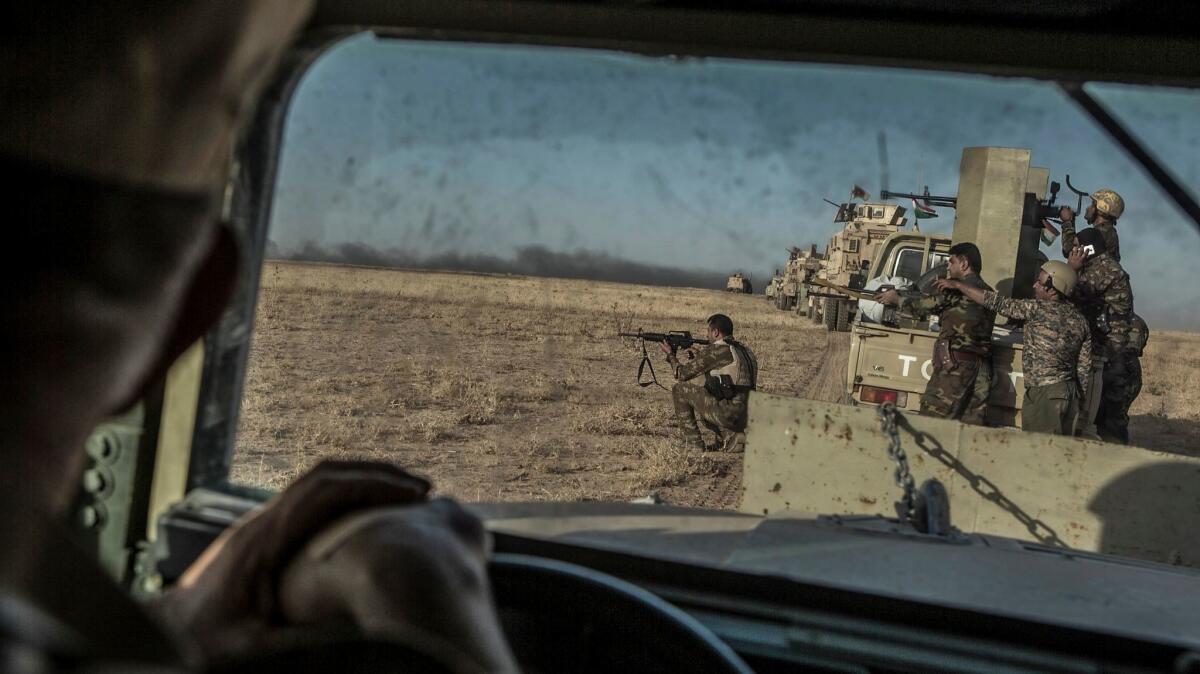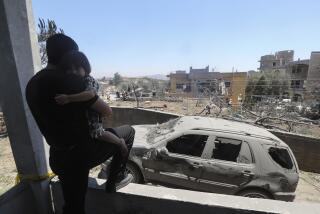Captured battlefield cellphones, computers help U.S. target and kill Islamic State’s leaders

- Share via
Reporting from Baghdad — U .S. military officers watched grainy video feeds at a small operations center in Baghdad on Tuesday as Predator drones tracked and killed three reputed Islamic State leaders — one after another — in the offensive on Mosul.
The targeted air strikes were due in large part to intelligence extracted from cellphones, computer hard drives, memory cards and hand-written ledgers recovered from battlefields and towns taken from Islamic State fighters.
Recently captured intelligence also has proved useful in providing clues to detecting potential terrorist plots, tracking foreign fighters and identifying Islamic State supporters around the globe, U.S. officials said.
Video playlist: Mosul offensive
The largest data trove was recovered when U.S.-backed Syrian rebel forces recaptured Manbij, an Islamic State stronghold in northern Syria, in mid-August. Intelligence agencies recovered more than 120,000 documents, nearly 1,200 devices and more than 20 terabytes of digital information, officials said.
Brett McGurk, the special presidential envoy for the coalition fighting Islamic State, said the Manbij data trove has been especially invaluable.
In particular, the intelligence from Manbij and other source has led to arrests or broken up plots in 15 countries in Europe, the Middle East, Southeast Asia, Africa, Latin America and in Canada, McGurk told a news conference on Oct. 7.
“If we get a phone off of a dead ISIL fighter in Manbij and it has a number of telephone numbers into a particular capital or city around the world, we share that information with the coalition members so that they can conduct their own investigation,” McGurk said, using an acronym for Islamic State.
Intelligence specialists are still combing through the data, but it has led to new details on how fighters are organized within the group’s hierarchy. That has helped military planners prepare the ground assault on Mosul that began last week.
The Pentagon recently sent about 100 additional special operations analysts, linguists and technicians to exploit information taken from towns around Mosul as Iraqi and Kurdish ground forces advance through concentric belts of booby traps, snipers and suicide bombers.
The goal is to “make sure we take advantage of the captured enemy material that is coming off of places like Manbij and will come out of Mosul,” said Gen. Joseph Votel, commander of U.S. forces in the Middle East, who was in Baghdad on Tuesday with McGurk.
The intelligence has allowed U.S. commanders to “understand what [Islamic State is] doing, what it might mean for foreign fighters that have been through there, what it might mean for future plans,” he said. “It’s a lesson we learned the hard way the last time we were in Iraq.”
U.S. forces were slow to break into militants’ communications and electronic devices during the 2003 invasion of Iraq, when Votel commanded the 75th Ranger Regiment, the Army’s premier light infantry and special operations unit.
He indicated they may have missed opportunities to find clues about the fierce Sunni insurgency that erupted after the invasion and ultimately give rise to Islamic State.
Now U.S. special operations commanders may forbid launching an airstrike at houses or compounds — even if known militant leaders are inside — for fear of destroying a useful cache of information and electronics.
Islamic State leadership includes former Iraqi military officers and others who served under ousted ruler Saddam Hussein. They tend to keep detailed records, officials say, which has helped analysts understand the group’s structure and map its hierarchy with tiers and rows.
“The expertise and senior leader cadre sets the pace of sustaining the organization,” a U.S. defense official said, speaking on condition of anonymity to discuss internal assessments. “They fashion themselves as a pseudo-governmental structure where you have financiers and ministers and all these other components. You need to take that all away from them.”
Targeting by Joint Special Operations Command has killed 39 Islamic State leaders in and around Mosul since July 1, U.S. officials said.
No one is yet sure how Islamic State will fight once Iraqi Security Forces and the Kurdish fighters known as peshmerga break through the group’s defensive perimeter around Mosul, or how they will leave the city.
Before they abandoned Ramadi earlier this year, militants planted booby traps in “baby cribs and closets” so people could not return to their homes, McGurk said Tuesday.
The coalition campaign to wipe out the group’s leadership has taken a growing toll on the group’s ability to control territory and to conduct sustained offensives, according to U.S. officials.
Small groups of militants launched surprise attacks last week in Kirkuk and Rutba, but coalition forces quickly fought back. Kirkuk was recaptured, and Iraqi ground troops, backed by a U.S. B-52 bomber, were pushing them back in Rutba, officials said.
“There’s no more leadership for them,” said Iraqi Brig. Gen. Tahseen Ibrahim Khafaji. “Who do they have to follow? It’s chaos.”
During the advance on Mosul, for example, Iraqi forces had to retake Sharqat, a rural town less than a hour’s drive to the south.
Islamic State’s local leader was killed in an airstrike. When a replacement was dispatched to govern the town and direct fighters, his vehicle also was hit with an airstrike.
Iraqi forces recaptured the town in just two days.
More to Read
Sign up for Essential California
The most important California stories and recommendations in your inbox every morning.
You may occasionally receive promotional content from the Los Angeles Times.










